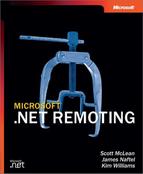Book Description
Learn how to leverage .NET Remoting to build scalable Internet-based distributed applications!
The Microsoft .NET Framework offers a flexible model for creating and extending distributed applications through remote object interaction: .NET Remoting. Discover the ins and outs of this advanced object technology with this authoritative guide—written by three expert .NET developers. The book discusses all aspects of .NET Remoting, with in-depth coverage of the .NET Remoting architecture. You'll learn how to use the technology's advanced extensibility hooks and unprecedented interoperability to build distributed, Internet-based applications that are fault tolerant, scalable, secure, fast, and easy to maintain and administer. You'll also find concrete examples, best practices, performance tips, and astute lessons on how to extend and customize distributed applications with .NET Remoting's pluggable architecture for solving complex problems.
Table of Contents
- Copyright
- Dedication
- Acknowledgments
- Introduction
- Understanding Distributed Application Development
- Understanding the .NET Remoting Architecture
- Building Distributed Applications with .NET Remoting
- SOAP and Message Flows
- Messages and Proxies
- Message Sinks and Contexts
- Channels and Channel Sinks
- Serialization Formatters
- About the Author
